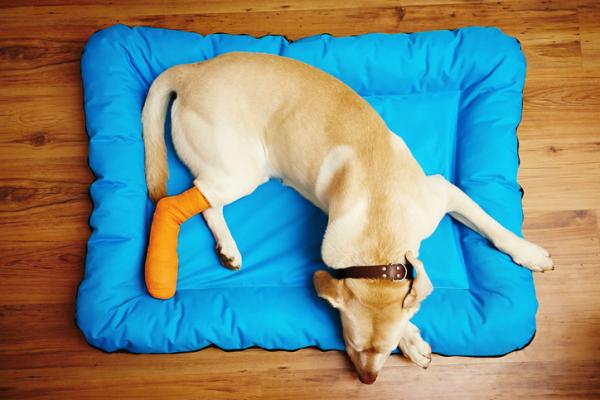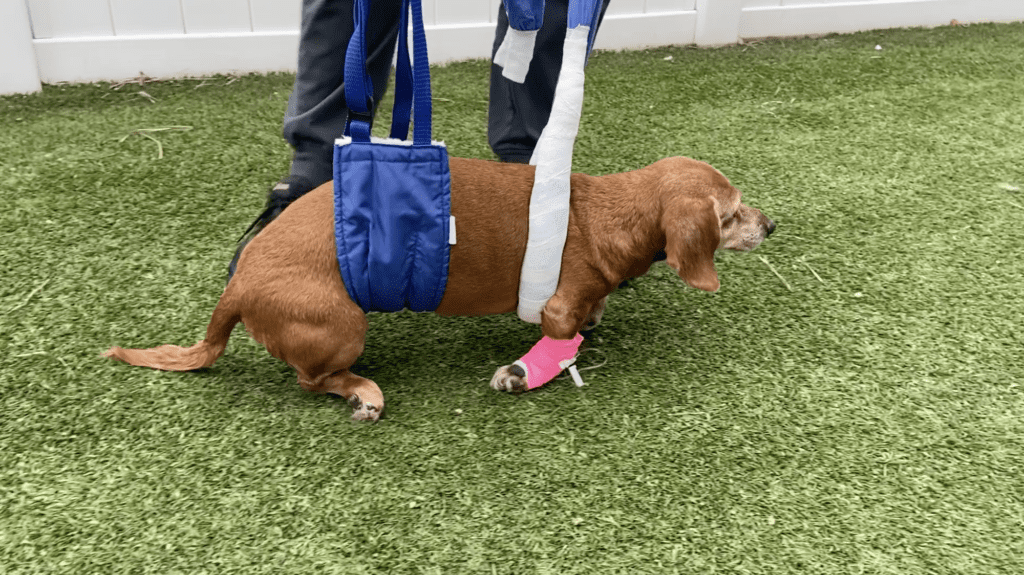Have you noticed that your dog tries to walk and falls, limps or fails one leg? Do you wonder why my dog can’t walk or stand up, why does my dog lose his balance when walking, or why the dog can’t stand up or walk? These are some doubts that arise as soon as we see that the balance and some of the legs of our faithful companion fail.
If this is your case, do not let it pass and go quickly to the vet to diagnose the cause that produces this problem to prevent it from getting worse and, as a result, your dog cannot walk. If you want to know the causes that answer your question about ” why can’t my dog walk? “, In this article, we explain several causes why your dog could be having this problem. You can try All-Natural CBD Treats For Your Dog
Why dog can’t stand up or walk?
Arthritis and osteoarthritis in dogs
Arthritis and osteoarthritis are two causes that can cause your dog to stop walking. In this case, this condition occurs in the knee and hip joints, causing pain by deteriorating the discs or cushions. The pain it causes, in turn, makes the dog move little and, therefore, the muscles atrophy. If this happens and your friend cannot move or cannot move a leg, surely, arthritis and/or osteoarthritis are already in a somewhat advanced state. Physical therapy and some medications help reduce symptoms so your friend can have as normal a life as possible and walk somewhat better.
Continue reading: Do ants sleep
Degenerative myelopathy in dogs
This disease is usually a common cause why a dog may be having trouble walking. It is about spinal cord deterioration, so dogs that have this problem cannot walk normally or stay on their feet for a long time. Although there is no definitive treatment for degenerative myelopathy in dogs, physical therapy and holistic medicine can help with symptoms.
If you ask yourself, “why can’t my dog walk with his hind legs ?”, This may be a cause, since, at the beginning of the pathology, they lose mobility in the hind legs and finally lose control of them. However, this can also happen due to nervous, endocrine, orthopedic problems or due to a blow where the back or spinal cord has been damaged.
Crossover breakage
It is one of the most common causes of lameness in small and old dogs. It is the total or partial rupture of one of the knee ties and the dog may stop walking due to the pain it causes or even because the joint itself no longer works as it should.
The solution is surgical, and anti-inflammatories and muscle strengthening with physical therapy can reduce pain and lameness.
You may like: Can cats eat raw chicken?
Necrosis of the head of the femur
This disease mainly affects small breed dogs and always young growing animals. It can be unilateral or bilateral femoral head necrosis. The problem begins with a poor blood supply to the head of the femur during growth, which would hinder its proper growth and development, and is diagnosed with X-rays.
The symptoms of this problem that can cause a dog to stop walking are pain, lameness, atrophy of the muscles of this limb, etc. Treatment consists of excision or removal of the head and neck of the femur since the tissue in the area has died.
Hip dysplasia in dogs
It is typical of large dogs and is hereditary. It can occur in young dogs and, therefore, it is necessary to take X-rays to give a diagnosis as soon as possible. In addition, in elderly dogs, it is also frequent.
In hip dysplasia in dogs, the acetabulum (hole in the pelvic bone that houses the head of the femur, that is, the point of attachment in the joint) and the head of the femur are deformed until the head of the femur enters and leaves the acetabulum very easily, which makes the joint not function as such. This produces symptoms such as pain, lameness, and difficulty getting up in dogs that suffer from it. The treatment goes through chondroprotective and NSAIDs, in addition to the prevention of obesity. There is preventive surgery that can be considered in puppies of predisposed breeds after the preventive radiological study.
Other causes of a dog’s leg failure
If you have observed that your dog’s hind legs fail or he cannot walk with any of them, it may not only be due to degenerative myelopathy or one of the causes already explained. If your dog stops walking completely and suddenly, that is, it seems to have become paralyzed, it is probably due to one of these other causes. In addition, in these cases, it is also common for the can to tremble.
- Strong blow: In the event of a trauma or an accident, your dog may not be able to walk if any limb has been damaged. Your dog will not walk due to the pain it produces, which can be temporary, but if it lasts a few hours, you will have to take him to the vet.
- Encephalitis or brain inflammation: This originates due to a primary cause such as distemper. This problem causes the dog to convulse, have weakness, cannot walk or walk uncoordinated or falls, in addition to producing a fever. The veterinarian will be in charge of treating this problem depending on the cause. Dogs that frequently recover from distemper have neurological sequelae or seizures. There are other pathologies that could produce this secondary problem.
- Poisoning: If your dog has ingested a substance toxic to its body, vomiting, bloody diarrhea, spasms, incoordination when walking and paralysis will surely appear. Given this, go to the vet so that he can treat the poisoning as soon as possible. Treatment varies depending on the substance and amount ingested.
- Metabolic, congenital or nervous system diseases: Faced with a pathology like these, your dog will be weak and it is possible that he cannot walk or walk unstably at times. The veterinarian will be in charge of examining and treating him depending on the disease causing the problem.
What to do if my dog can’t walk?
If you have observed that your dog cannot walk and you wonder what to do when a dog’s hind legs fail or cannot walk, the best thing you can do is go to the vet since practically all the causes that produce this problem must be treated. By someone professional to solve them or prevent them from getting worse, the only exception would be a not very strong blow from which the pain it produces disappears quickly.
You can examine your dog’s body for any injury, wound, or blow to see if this is why your dog is unable to walk and why it hurts. If you do not find anything, do not wait and go to the vet to rule out or treat problems that may damage the functioning of your dog’s body. You can carry him in your arms when necessary, pass a long scarf over the dog’s hip to raise it and help him walk (like a wheelbarrow), put him in a wheelchair if necessary, as well as follow the treatments indicated by the veterinarian (from surgeries to medications and therapies )
Tags: dog can't standup, dog can't walk






Leave a Reply